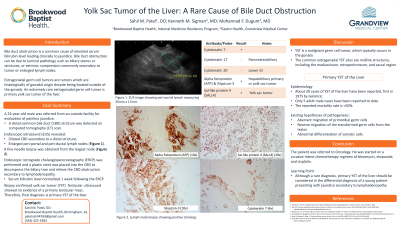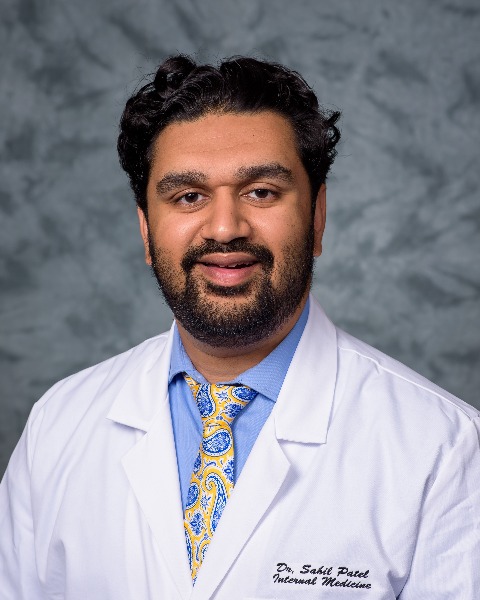Sunday Poster Session
Category: Liver
P1018 - Yolk Sac Tumor of the Liver: A Rare Cause of Bile Duct Obstruction
Sunday, October 22, 2023
3:30 PM - 7:00 PM PT
Location: Exhibit Hall

Has Audio

Sahil M. Patel, DO
Brookwood Baptist Health
Birmingham, AL
Presenting Author(s)
Sahil M. Patel, DO1, Kenneth M. Sigman, MD2, Mohannad F. Dugum, MD2
1Brookwood Baptist Health, Birmingham, AL; 2Gastro Health, Grandview Medical Center, Birmingham, AL
Introduction: This case report describes a rare extragonadal germ cell tumor, primary yolk sac tumor (YST) of the liver, which should be included in the differential of a young adult presenting with painless jaundice. There have been approximately 20 reported cases, the first being in 1975, of which only 5 are adult males. The estimated mortality rate for patients diagnosed with YST of the liver is greater than 50%.
Case Description/Methods: A 32-year-old male was referred from an outside facility for evaluation of painless jaundice. He had multiple prior hospitalizations which revealed a recurring distal common bile duct (CBD) stricture despite multiple biliary stent placements. A CT scan was obtained and redemonstrated the distal CBD stricture. An EUS was then performed, showing enlarged peri-portal and peri-ductal lymph nodes in addition to a dilated CBD secondary to a distal stricture. A fine need biopsy (FNB) was obtained from the largest peri-ductal lymph node. An ERCP was then performed with placement of a plastic biliary stent to decompress the biliary tree and relieve the CBD obstruction secondary to lymphadenopathy. His serum bilirubin levels normalized 1 week later. FNB staining was consistent with YST. Subsequently, a testicular ultrasound was performed, but showed no evidence of a primary testicular mass, which confirmed the diagnosis of a primary YST of the liver. The patient was referred to oncology where he started a curative-intent chemotherapy regimen of bleomycin, etoposide, and cisplatin.
Discussion: There are three existing hypotheses for YST of the liver pathogenesis: aberrant migration of primordial germ cells, reverse migration of the transformed germ cells from the testes, and abnormal differentiation of somatic cells. FNB stained positive for cytokeratin 7, alpha fetoprotein, and glypican-3, which suggested either adenocarcinoma or YST. A positive sal-like protein 4 stain confirmed the presence of YST. Given this similar staining pattern between adenocarcinoma and YST, it is important to consider YST in the differential diagnosis. Primarily because its management is very different often needing only chemotherapy and not a Whipple procedure as usually seen with adenocarcinoma.
Disclosures:
Sahil M. Patel, DO1, Kenneth M. Sigman, MD2, Mohannad F. Dugum, MD2. P1018 - Yolk Sac Tumor of the Liver: A Rare Cause of Bile Duct Obstruction, ACG 2023 Annual Scientific Meeting Abstracts. Vancouver, BC, Canada: American College of Gastroenterology.
1Brookwood Baptist Health, Birmingham, AL; 2Gastro Health, Grandview Medical Center, Birmingham, AL
Introduction: This case report describes a rare extragonadal germ cell tumor, primary yolk sac tumor (YST) of the liver, which should be included in the differential of a young adult presenting with painless jaundice. There have been approximately 20 reported cases, the first being in 1975, of which only 5 are adult males. The estimated mortality rate for patients diagnosed with YST of the liver is greater than 50%.
Case Description/Methods: A 32-year-old male was referred from an outside facility for evaluation of painless jaundice. He had multiple prior hospitalizations which revealed a recurring distal common bile duct (CBD) stricture despite multiple biliary stent placements. A CT scan was obtained and redemonstrated the distal CBD stricture. An EUS was then performed, showing enlarged peri-portal and peri-ductal lymph nodes in addition to a dilated CBD secondary to a distal stricture. A fine need biopsy (FNB) was obtained from the largest peri-ductal lymph node. An ERCP was then performed with placement of a plastic biliary stent to decompress the biliary tree and relieve the CBD obstruction secondary to lymphadenopathy. His serum bilirubin levels normalized 1 week later. FNB staining was consistent with YST. Subsequently, a testicular ultrasound was performed, but showed no evidence of a primary testicular mass, which confirmed the diagnosis of a primary YST of the liver. The patient was referred to oncology where he started a curative-intent chemotherapy regimen of bleomycin, etoposide, and cisplatin.
Discussion: There are three existing hypotheses for YST of the liver pathogenesis: aberrant migration of primordial germ cells, reverse migration of the transformed germ cells from the testes, and abnormal differentiation of somatic cells. FNB stained positive for cytokeratin 7, alpha fetoprotein, and glypican-3, which suggested either adenocarcinoma or YST. A positive sal-like protein 4 stain confirmed the presence of YST. Given this similar staining pattern between adenocarcinoma and YST, it is important to consider YST in the differential diagnosis. Primarily because its management is very different often needing only chemotherapy and not a Whipple procedure as usually seen with adenocarcinoma.
Disclosures:
Sahil Patel indicated no relevant financial relationships.
Kenneth Sigman indicated no relevant financial relationships.
Mohannad Dugum indicated no relevant financial relationships.
Sahil M. Patel, DO1, Kenneth M. Sigman, MD2, Mohannad F. Dugum, MD2. P1018 - Yolk Sac Tumor of the Liver: A Rare Cause of Bile Duct Obstruction, ACG 2023 Annual Scientific Meeting Abstracts. Vancouver, BC, Canada: American College of Gastroenterology.
